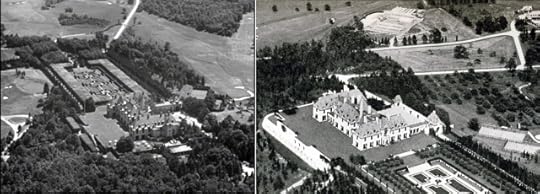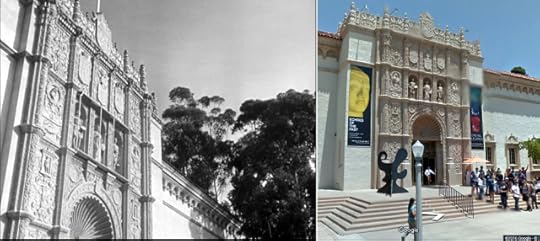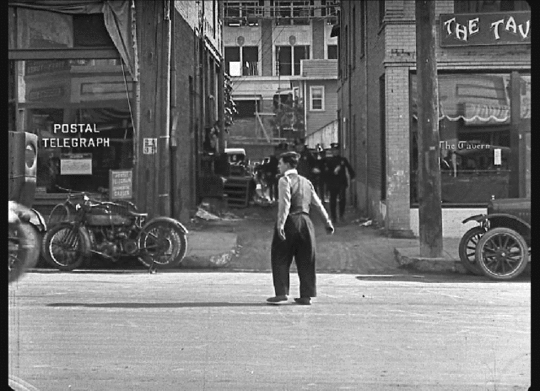John Bengtson's Blog, page 18
November 6, 2016
How Chaplin Filmed The Champion – on Location in Niles
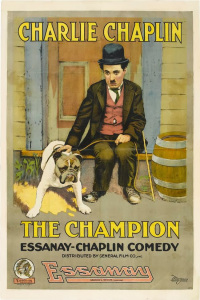 The upcoming San Francisco Silent Film Festival’s Day of Silents winter program this December 3 at the Castro Theater offers something for everyone, from Ernst Lubitsch’s 1926 Jazz Age gem So This is Paris, to the Oscar’s first ever Best Actor performance, Emil Janning’s portrayal of an exiled Russian general turned Hollywood extra in The Last Command (1928). The morning program leads off with three beautifully restored shorts Charlie Chaplin filmed for the Essanay Film Company in 1915, and co-presented by the Niles Essanay Silent Film Museum. In addition to His New Job, filmed at the Essanay Studio in Chicago, and A Night in the Show, where Chaplin plays dual roles, we’ll be seeing The Champion, a boxing comedy filmed entirely on location in Niles, the second of five films Chaplin made for Essanay during his brief stay in the Bay Area before returning to Los Angeles to finish out his one-year contract with the studio.
The upcoming San Francisco Silent Film Festival’s Day of Silents winter program this December 3 at the Castro Theater offers something for everyone, from Ernst Lubitsch’s 1926 Jazz Age gem So This is Paris, to the Oscar’s first ever Best Actor performance, Emil Janning’s portrayal of an exiled Russian general turned Hollywood extra in The Last Command (1928). The morning program leads off with three beautifully restored shorts Charlie Chaplin filmed for the Essanay Film Company in 1915, and co-presented by the Niles Essanay Silent Film Museum. In addition to His New Job, filmed at the Essanay Studio in Chicago, and A Night in the Show, where Chaplin plays dual roles, we’ll be seeing The Champion, a boxing comedy filmed entirely on location in Niles, the second of five films Chaplin made for Essanay during his brief stay in the Bay Area before returning to Los Angeles to finish out his one-year contract with the studio.

During this early scene Charlie and his little pal walk south down G Street in Niles, beside the Essanay Studio fence, towards studio bungalows that still stand today.
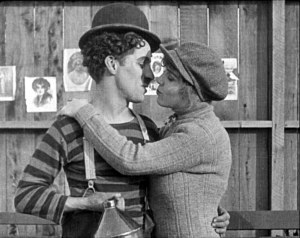 As reported here, The Champion provides charming views of early Niles, including the former Essanay Studio facility that once stood at the corner of Niles Boulevard and G Street. During the film, Charlie’s hungry tramp character signs up to be a boxing sparring partner, only to end up winning the championship and Edna Purviance’s affections. Chaplin was an avid boxing fan, and by the time of filming had started on off-screen romance with Purviance, whom he had only recently hired to be his first leading lady.
As reported here, The Champion provides charming views of early Niles, including the former Essanay Studio facility that once stood at the corner of Niles Boulevard and G Street. During the film, Charlie’s hungry tramp character signs up to be a boxing sparring partner, only to end up winning the championship and Edna Purviance’s affections. Chaplin was an avid boxing fan, and by the time of filming had started on off-screen romance with Purviance, whom he had only recently hired to be his first leading lady.

Looking south at Chaplin’s path down G Street beside the Essanay Studio, built in 1913.

Looking NW at G Street and 2nd – Essanay built these bungalows for studio employees. To the far right is the home appearing with Charlie in the fence scene above.

A modern fire station with retro design now stands on the corner where the Essanay facility stood from 1913 to 1933 – the bungalows appear to the left. (C) Google Street View.

Looking west at the side of the Essanay Studio. The house at left appears in the Chaplin frame. At right, Charlie chases a boxer through the gate in the studio fence. Notice the enclosed glass shooting stage appearing behind Charlie’s head.

Looking north – filming The Champion within the glass shooting stage, visible behind Charlie in the prior scene.

Looking east – when Charlie chases a boxer out of the studio fence gate, the southern face of the Township Register newspaper building appears at back. The inset shows the other side of the building.

Looking east, Charlie struts and performs calisthenics within the fenced-in studio grounds. Above is a similar view east taken in Niles before the studio was built in 1913. The top of the extant Edison Theater (box) peeks over the fence, while the color view shows the side of the theater today, now home to the Niles Essanay Silent Film Museum. Charlie walked his dog from left to right along the outside of this fence. (C) Google Street View.

Looking SW at the corner of the studio at G Street, and the studio fence gate (arrow). Notice the glass stage behind Charlie.
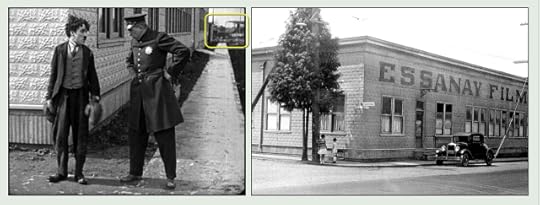
Click to enlarge – Charlie captures the attention of a policeman in this view looking west along the front of the studio. The bleachers for the adjacent Sullivan Park baseball field (box) appears in the upper right corner (see below).

Click to enlarge – looking north, this frame from Ben Turpin’s 1915 comedy Snakeville’s Champion shows the Sullivan Park baseball field, due west of the studio. The inset from Charlie’s scene in The Champion, reversed here for comparison, shows the park’s shaded bleachers. Turpin and Chaplin made two films together for Essanay, His New Job filmed in Chicago, and A Night Out filmed in Niles and Oakland.

Click to enlarge – looking NE, this panoramic view of the ball park combines frames from Ben Turpin’s film. The inset shows the Essanay Studio baseball team in 1913. Second from the right stands Rollie Totheroh, who would become Chaplin’s cameraman for 26 years. This ball field stood due west of the studio. Historian David Kiehn writes that Chaplin did not necessarily endear himself to the townspeople during his brief stay. Notorious for his huge salary and signing bonus with Essanay, widely publicized at the time, Chaplin reportedly didn’t tip local waitresses, pay for his rounds at the bar, and mooched walnuts at the general store. “He was a shy person off-camera, and I think he tried to make up for it by pretending to be outgoing,” says Kiehn. “There are stories that at baseball games he would go under the bleachers and pinch the bottoms of women.” Presumably any bottom-pinching in Niles would have taken place here.
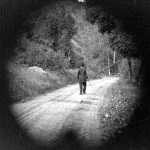 Chaplin’s boss and Essanay co-founder Gilbert M. “Broncho Billy” Anderson, cinema’s first cowboy star, had been making films at Niles for a couple of years before Charlie arrived there in late January 1915. This recent post explains how Chaplin filmed the iconic shot of his Little Tramp traipsing down a country road, the concluding scene from The Tramp, at the same spot where Anderson had previously filmed action scenes for his cowboy films. The Tramp was Chaplin’s final
Chaplin’s boss and Essanay co-founder Gilbert M. “Broncho Billy” Anderson, cinema’s first cowboy star, had been making films at Niles for a couple of years before Charlie arrived there in late January 1915. This recent post explains how Chaplin filmed the iconic shot of his Little Tramp traipsing down a country road, the concluding scene from The Tramp, at the same spot where Anderson had previously filmed action scenes for his cowboy films. The Tramp was Chaplin’s final 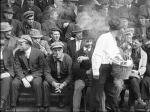 production during his 10-week stint in Niles before heading to Los Angeles. Anderson and Chaplin became friends working together in Niles. At the right, Anderson plays a cameo in The Champion, seen here staring into the camera, as an extra watching Charlie’s boxing match. You can purchase a newly released two DVD set containing 16 Anderson Broncho Billy films, shot mostly at Niles, HERE.
production during his 10-week stint in Niles before heading to Los Angeles. Anderson and Chaplin became friends working together in Niles. At the right, Anderson plays a cameo in The Champion, seen here staring into the camera, as an extra watching Charlie’s boxing match. You can purchase a newly released two DVD set containing 16 Anderson Broncho Billy films, shot mostly at Niles, HERE.
All vintage images courtesy of David Kiehn, historian for the Niles Essanay Silent Film Museum, and author of the wonderful history of the studio, Broncho Billy and the Essanay Film Company. You can read more about Chaplin filming The Champion in my book Silent Traces.
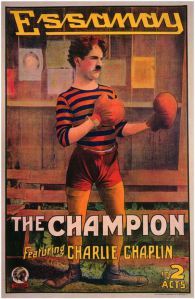 Preservationist Serge Bromberg of Lobster Films, and Cineteca di Bologna, have restored all 15 of Chaplin’s 1915 Essanay short comedies, available as a 5 disc Blu-ray/DVD box set from Flicker Alley. The restoration of The Champion was made possible thanks to the generous support of the Niles Essanay Silent Film Museum.
Preservationist Serge Bromberg of Lobster Films, and Cineteca di Bologna, have restored all 15 of Chaplin’s 1915 Essanay short comedies, available as a 5 disc Blu-ray/DVD box set from Flicker Alley. The restoration of The Champion was made possible thanks to the generous support of the Niles Essanay Silent Film Museum.
All images from Chaplin films made from 1918 onwards, copyright © Roy Export Company Establishment. CHARLES CHAPLIN, CHAPLIN, and the LITTLE TRAMP, photographs from and the names of Mr. Chaplin’s films are trademarks and/or service marks of Bubbles Incorporated SA and/or Roy Export Company Establishment. Used with permission.
Filed under: Charlie Chaplin Tagged: Chaplin Locations, Charlie Chaplin, Essanay Studio, Niles Essanay Silent Film Museum, Silent Comedians, Silent Comedies, Silent Movie Locations, Silent Movies, The Champion, then and now

October 25, 2016
The Chaplin – Keaton – Lloyd Hollywood Alley
 Three of the greatest silent comedies of all time, Charlie Chaplin’s The Kid (1921), Buster Keaton’s Cops (1922), and Harold Lloyd’s Safety Last! (1923), were each filmed at a small Hollywood alley you can still visit today. Running east-west between Cahuenga and Cosmo just south of Hollywood Boulevard, the unnamed alley was conveniently located to the studios, while providing a secluded spot to shoot. Each film has been inducted into the National Film Registry of the Library of Congress as a work of enduring importance to American culture.
Three of the greatest silent comedies of all time, Charlie Chaplin’s The Kid (1921), Buster Keaton’s Cops (1922), and Harold Lloyd’s Safety Last! (1923), were each filmed at a small Hollywood alley you can still visit today. Running east-west between Cahuenga and Cosmo just south of Hollywood Boulevard, the unnamed alley was conveniently located to the studios, while providing a secluded spot to shoot. Each film has been inducted into the National Film Registry of the Library of Congress as a work of enduring importance to American culture.
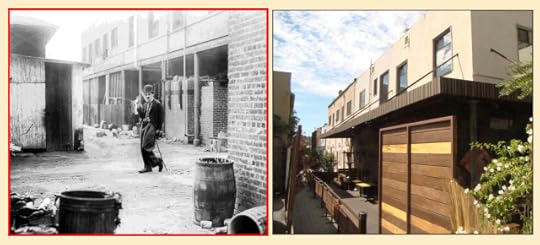
Looking south, Charlie Chaplin in The Kid.
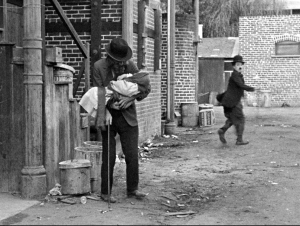 It was here Charlie’s Little Tramp discovers the abandoned infant he will raise as his son (portrayed as a child by Jackie Coogan) during the opening scenes from The Kid. This main view looks south, where a patio dining area blocks some of the view today. Another scene (right) shows Charlie running north towards the same spot. As posted HERE, Charlie and Jackie Coogan reunite emotionally later in the film at Olvera Street downtown.
It was here Charlie’s Little Tramp discovers the abandoned infant he will raise as his son (portrayed as a child by Jackie Coogan) during the opening scenes from The Kid. This main view looks south, where a patio dining area blocks some of the view today. Another scene (right) shows Charlie running north towards the same spot. As posted HERE, Charlie and Jackie Coogan reunite emotionally later in the film at Olvera Street downtown.

Looking east from Cahuenga, Buster Keaton in Cops.
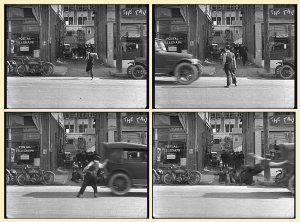 The west end of the alley on Cahuenga appears in Keaton’s most famous short film Cops. Chased by a mob of angry police, Buster stops in the street and grabs a passing car one-handed that whisks him out of frame to safety (left – click to enlarge). At back appears the extant Palmer Building on Cosmo, still under construction at the time, that would become the future home of the now defunct Hollywood Citizen newspaper. The art deco building on Cahuenga now standing to the left of the alley was completed in 1935 (designed by noted LA architects Morgan, Walls & Clements), making the alley slightly more narrow today.
The west end of the alley on Cahuenga appears in Keaton’s most famous short film Cops. Chased by a mob of angry police, Buster stops in the street and grabs a passing car one-handed that whisks him out of frame to safety (left – click to enlarge). At back appears the extant Palmer Building on Cosmo, still under construction at the time, that would become the future home of the now defunct Hollywood Citizen newspaper. The art deco building on Cahuenga now standing to the left of the alley was completed in 1935 (designed by noted LA architects Morgan, Walls & Clements), making the alley slightly more narrow today.
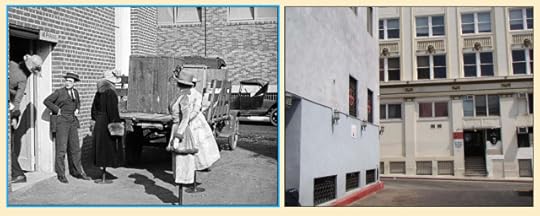
Looking east towards Cosmo, Harold Lloyd in Safety Last!
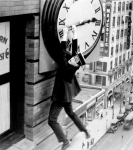 Lloyd is best remembered for hanging from a skyscraper clock in the stunt climbing thrill comedy Safety Last! Harold plays a department store salesman in this film, shown above calculating how to sneak in late to work. The east end of the alley portrayed the back of Harold’s store, where Lloyd filmed many scenes, with the Palmer Building on Cosmo forming a backdrop.
Lloyd is best remembered for hanging from a skyscraper clock in the stunt climbing thrill comedy Safety Last! Harold plays a department store salesman in this film, shown above calculating how to sneak in late to work. The east end of the alley portrayed the back of Harold’s store, where Lloyd filmed many scenes, with the Palmer Building on Cosmo forming a backdrop.

Click to enlarge – looking NE at the alley running from Cahuenga (left) to Cosmo (right).
You can read more details about Chaplin, Keaton, and Lloyd filming at this alley HERE, how the alley appears in Harry Houdini’s 1919 feature The Grim Game HERE, how the site appears in the 1994 Johnny Depp/Tim Burton movie Ed Wood HERE, and how it appears in the newly discovered closing shot from Keaton’s 1922 short My Wife’s Relations HERE.
All images from Chaplin films made from 1918 onwards, copyright © Roy Export Company Establishment. CHARLES CHAPLIN, CHAPLIN, and the LITTLE TRAMP, photographs from and the names of Mr. Chaplin’s films are trademarks and/or service marks of Bubbles Incorporated SA and/or Roy Export Company Establishment. Used with permission.
Cops (1922) licensed by Douris UK, Ltd.
HAROLD LLOYD images and the names of Mr. Lloyd’s films are all trademarks and/or service marks of Harold Lloyd Entertainment Inc. Images and movie frame images reproduced courtesy of The Harold Lloyd Trust and Harold Lloyd Entertainment Inc.
Hollywood map detail © 1938 Thomas Bros. – David Rumsey Map Collection. Aerial photos courtesy HollywoodPhotographs.com and Marc Wanamaker – Bison Archives.
Filed under: Buster Keaton, Charlie Chaplin, Cops, Harold Lloyd, Hollywood Tour, Safety Last!, The Kid Tagged: Buster Keaton, Cahuenga, Chaplin - Keaton - Lloyd Alley, Charlie Chaplin, Cops, Cosmo, East Cahuenga Alley, Harold Lloyd, Hollywood, Safety Last!, Silent Comedians, Silent Comedies, Silent Movie Locations, Silent Movies, The Kid, then and now

October 15, 2016
Chaplin’s The Tramp – ‘New’ Views of One of Cinema’s Most Iconic Scenes
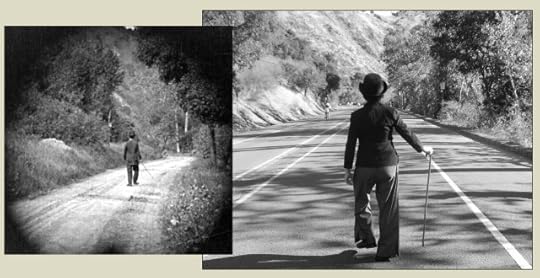
The iconic final scene from The Tramp (1915) (left) recreated in 2016 by Alani Taira (photo by Rena Azevedo Kiehn) – the opening scene below.
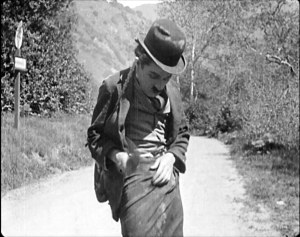 Forever known as “the Little Tramp,” Charlie Chaplin filmed his eponymous short film The Tramp for the Essanay company over 100 years ago in Niles, California. When Chaplin arrived at the Bay Area studio early in 1915, the small rural facility had already produced dozens of comedies and westerns, many starring Chaplin’s boss and Essanay co-founder Gilbert M. “Broncho Billy” Anderson, cinema’s first cowboy star.
Forever known as “the Little Tramp,” Charlie Chaplin filmed his eponymous short film The Tramp for the Essanay company over 100 years ago in Niles, California. When Chaplin arrived at the Bay Area studio early in 1915, the small rural facility had already produced dozens of comedies and westerns, many starring Chaplin’s boss and Essanay co-founder Gilbert M. “Broncho Billy” Anderson, cinema’s first cowboy star.
During The Tramp, Charlie falls for a kind-hearted farm girl played by Edna Purviance, but when he learns that she has a sweetheart, Charlie sadly returns to the open road. The comedy’s bittersweet ending was novel for its time, and provides one of the most poignant and enduring images in cinema history – the Little Tramp, traipsing down a lonesome road, his back to the audience, downtrodden, but suddenly straightening up, ready for a new adventure, as the camera irises in for the final fade out.

The same road sign, trees, and hillside features appear in the closing (left) and opening (right) scenes.
As I report in my book Silent Traces, Chaplin film location expert Gerald Smith made the incredible discovery that this lonely stretch of road can still be visited today along Niles Canyon Road. As shown above, it turns out that Charlie’s opening scene, dodging speeding cars, was filmed just a bit further west of the same spot as the closing scene.

Click to enlarge. The Escape of Broncho Billy (1915) (left) and Broncho Billy’s Sentence (1915) (right), with matching hillside features as The Tramp (arrow), all filmed on Niles Canyon Road.
 But we now have even a broader perspective of this iconic setting. Thanks to the tireless efforts of Larry Telles, who funded and oversaw the project, the Niles Essanay Silent Film Museum has just released a wonderful DVD featuring 16 early Broncho Billy westerns, filmed mostly at Niles from between 1912 to 1915, and ably accompanied by talented musicians Frederick Hodges and David Drazin; Broncho Billy Anderson: Film Pioneer. This DVD marks the first time these 16 films have been available on home video, and nearly every title was transferred from a beautiful, clear print. At just $25 including tax and shipping, this fascinating DVD is a terrific value, and supports the museum’s worthy cause.
But we now have even a broader perspective of this iconic setting. Thanks to the tireless efforts of Larry Telles, who funded and oversaw the project, the Niles Essanay Silent Film Museum has just released a wonderful DVD featuring 16 early Broncho Billy westerns, filmed mostly at Niles from between 1912 to 1915, and ably accompanied by talented musicians Frederick Hodges and David Drazin; Broncho Billy Anderson: Film Pioneer. This DVD marks the first time these 16 films have been available on home video, and nearly every title was transferred from a beautiful, clear print. At just $25 including tax and shipping, this fascinating DVD is a terrific value, and supports the museum’s worthy cause.
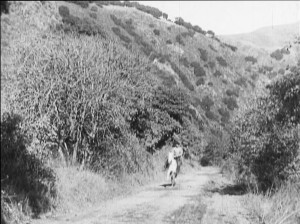 Having filmed in the Niles area for years, Anderson had ample time to find his favorite places to shoot; a twist in the road here, a gully there, as clearly evidenced in these 16 films. So when it turns out that Chaplin’s iconic filming spot for The Tramp appears
Having filmed in the Niles area for years, Anderson had ample time to find his favorite places to shoot; a twist in the road here, a gully there, as clearly evidenced in these 16 films. So when it turns out that Chaplin’s iconic filming spot for The Tramp appears  in Anderson’s films as well, it’s easy to imagine why. Perhaps during a lunch break, or over drinks at the nearby Hotel Wesley, Charlie likely mentioned to Anderson that he needed a certain setting for his latest film, and Anderson gladly obliged by recommending ‘his’ spot to Charlie.
in Anderson’s films as well, it’s easy to imagine why. Perhaps during a lunch break, or over drinks at the nearby Hotel Wesley, Charlie likely mentioned to Anderson that he needed a certain setting for his latest film, and Anderson gladly obliged by recommending ‘his’ spot to Charlie.
Although a busy two-lane highway today, Chaplin and Anderson’s filming spot still stands, a bit west of the blue emergency phone sign AL-84-125, along Niles Canyon Road east of town.
You can purchase the new Broncho Billy DVD HERE. To learn more about Broncho Billy, and the Essanay studio at Niles, be sure to check out historian David Kiehn’s invaluable book Broncho Billy and the Essanay Film Company.
Thanks to preservationist Serge Bromberg of Lobster Films, and Cineteca di Bologna, all 15 of Chaplin’s Essanay short comedies from 1915 have been beautifully restored, available as a 5 disc Blu-ray/DVD box set from Flicker Alley. All images from Chaplin films made from 1918 onwards, copyright © Roy Export Company Establishment. CHARLES CHAPLIN, CHAPLIN, and the LITTLE TRAMP, photographs from and the names of Mr. Chaplin’s films are trademarks and/or service marks of Bubbles Incorporated SA and/or Roy Export Company Establishment. Used with permission.
Where Charlie AND Broncho Billy once filmed.
Filed under: Charlie Chaplin Tagged: Broncho Billy, Broncho Billy Anderson, Charlie Chaplin, Gilbert Anderson, Niles, Niles Essanay Silent Film Museum, Silent Comedians, Silent Comedies, Silent Movie Locations, Silent Movies, The Tramp, then and now

September 19, 2016
Silent Witness – the House that Watched Over Chaplin and Keaton
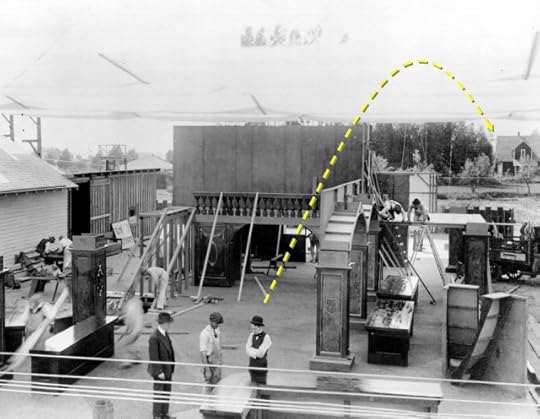
1022 Cole Avenue looms at back as Chaplin surveys construction of the department store set for his first Mutual production The Floorwalker (1916). Marc Wanamaker – Bison Archives.
The sturdy two-story home once located at 1022 Cole Avenue had a front row seat to some of the most remarkable scenes in early Hollywood history. Its rear dormer window looked down on the humble open air stage where Charlie Chaplin filmed his 12 Mutual comedy short films in 1916-1917, and where Buster Keaton later made his independently produced short and feature films (1920-1928). Moreover, the home appears peeking over the studio fence in many early scenes. One can only imagine the cinematic activity this home witnessed before it was demolished in 1929 to make way for the Technicolor Building, itself a landmark of Hollywood history, and now a Gold’s Gym.

This aerial view, likely taken March 7, 1921, shows the home relative to the open air stage that Keaton would close over later that year. Remnants of the Convict 13 prison guard tower set, discussed further below, can be seen in the far corner. The white wall near the prison set is Buster’s ‘WANTED’ poster appearing in The Goat. The Metro Studio front office buildings appear at top. HollywoodPhotographs.com.

1022 Cole, similar views – The Boat (left) – newly restored from The Blacksmith (right).
Since Buster filmed more frequently than Charlie on the studio backlot, the home makes several cameo appearances in Keaton’s early short films. Above the home stands watch over The Boat (1921), as Buster and family realize that towing a boat through a too-narrow basement doorway has just destroyed their domicile. The Cole home also appears in some of the remarkably restored Lobster Films 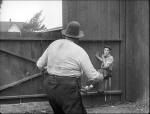 footage from The Blacksmith (1922) newly released by Kino-Lorber. The home first appears over the fence in these scenes with Buster and Big Joe Roberts filmed inside the studio gate on Cahuenga, above and at left.
footage from The Blacksmith (1922) newly released by Kino-Lorber. The home first appears over the fence in these scenes with Buster and Big Joe Roberts filmed inside the studio gate on Cahuenga, above and at left.

Click to enlarge – 1022 Cole (box) and upper right during the opening and closing scenes from Day Dreams.
Although fairly obscured by a fake garden fence, the home also appears during the opening and closing scenes from Day Dreams (1922) shown above, purportedly looking from Reneé Adorée’s front porch, as Buster dodges a car when first greeting her, and again during his return home, via parcel post, following his failure to strike it rich in the big city.

The arrow in this circa 1920 photo marks where Renee’s house would later be built for Day Dreams in 1922, facing a small vacant lot across the street, behind which stood 1022 Cole. HollywoodPhotographs.com.
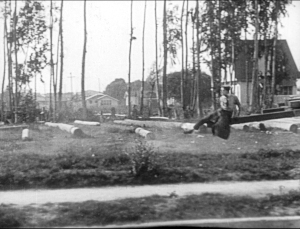
The Blacksmith – 1022 Cole at right
Chaplin and Keaton built their biggest sets in the empty backlot corner at Romaine and Cahuenga pictured at right above. Chaplin built the “T”-shaped tenement set for Easy Street (1917) at this corner, and likely built the fountain and spa exterior set from The Cure (1917) there as well. As explained further below, the above view shows both the prison set from Buster’s Convict 13 (1920), and Buster’s similarly configured tenement set from Neighbors (1920). Buster also used the small vacant lot across the  street from the studio (shown above) for many films including College (1927), where he built a dormitory set on the vacant lot. This vacant lot appears in many restored scenes from The Blacksmith (left), where in one shot (above) 1022 Cole appears again at back to the right.
street from the studio (shown above) for many films including College (1927), where he built a dormitory set on the vacant lot. This vacant lot appears in many restored scenes from The Blacksmith (left), where in one shot (above) 1022 Cole appears again at back to the right.

A closer view of the small corner backlot shows where Buster filmed this scene from The Boat.

This even closer view shows the Convict 13 prison set, and the Neighbors tenement set.
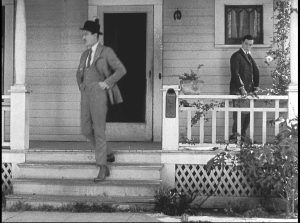
Note the 1022 address by the door.
While Day Dreams marked the final onscreen appearance for the back of the Cole Avenue home, Buster saved the best for last when filming Sherlock Jr. (1924), where the front of 1022 Cole portrays his fiancé’s family home. The home appears in full view when Buster pays Kathryn McGuire a visit, and again in closer view when Buster, an amateur detective, ponders whether to shadow his rival up the street. The 1022 address appears clearly visible beside the door, and in faded numbers on the front step.
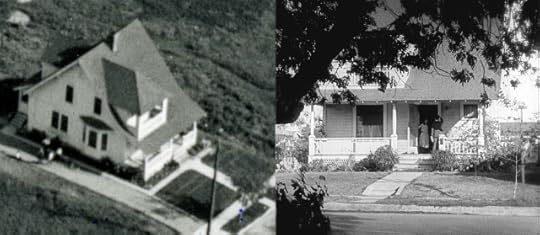
Click to enlarge – 1022 Cole in real life (left) and in “reel” life from Sherlock Jr. HollywoodPhotographs.com.
Geographically consistent, the following scene of Buster closely tracking Ward Crane’s every step and gesture was filmed looking east as they walk north from the home up Cole, providing a clear view of the Keaton Studio enclosed stage and corner barn, perhaps the only extant movie footage in which this historic studio appears.

Looking east from Cole towards the Keaton Studio barn and enclosed shooting stage. HollywoodPhotographs.com.
Frame images from Buster Keaton: The Shorts Collection 1917 – 1923 (C) 2016 Kino-Lorber, Lobster Films.
1022 Cole Avenue today.
Filed under: Buster Keaton, Charlie Chaplin, Daydreams, Sherlock Jr., The Blacksmith, The Boat Tagged: Buster Keaton, Chaplin Locations, Charlie Chaplin, Day Dreams, Keaton Studio, Silent Comedians, Silent Comedies, Silent Movie Locations, Technicolor Building, The Blacksmith, The Boat, The Floorwalker, then and now

September 12, 2016
The Modern Times – Citizen Kane – Humphrey Bogart Factory Gate

Charlie again out of work – tough times for Charles Foster Kane – matching views from Modern Times and Citizen Kane.
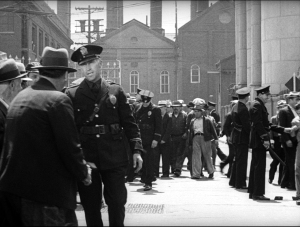 I recently watched Citizen Kane (1941) for the first time in years, broadcast on TCM, and enjoyed it thoroughly. Having seen it many times before, the scenes and the dialog were all familiar, but still powerful and engaging. But now that I’m afflicted with ‘location-itis’ I couldn’t help but notice a common setting appearing in the Orson Welles classic with a scene from Charlie Chaplin’s Modern Times (1936) (see above and right).
I recently watched Citizen Kane (1941) for the first time in years, broadcast on TCM, and enjoyed it thoroughly. Having seen it many times before, the scenes and the dialog were all familiar, but still powerful and engaging. But now that I’m afflicted with ‘location-itis’ I couldn’t help but notice a common setting appearing in the Orson Welles classic with a scene from Charlie Chaplin’s Modern Times (1936) (see above and right).
The closed factory gate depicting Charles Foster Kane reeling from the 1929 crash during the mock newsreel of his life at the outset of Citizen Kane is the same factory gate Chaplin used for the factory scenes late in Modern Times where Charlie and other workers recently re-hired after a long shutdown must suddenly go on strike, leaving Charlie once again out of work. You can read more about this Modern Times setting in my book Silent Traces.

Humphrey Bogart runs to save his job in The Great O’Malley (1937).
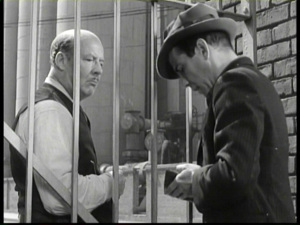
Bogie, down on his luck.
The year following Modern Times the factory gate appeared again during The Great O’Malley (1937), a Warner Bros. melodrama with Pat O’Brien in the lead. When by-the-book policeman O’Brien stops Humphrey Bogart for a minor traffic infraction, a loud muffler on his car, it causes Bogie to be late, losing his chance for a factory job. Unable to support his family, Bogart commits a petty crime and is sent to jail. O’Brien eventually learns compassion, and secretly helps Bogie’s family, and helps
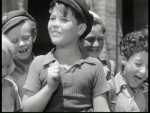
Delmar Watson
arrange for his early parole. Delmar Watson appears with a credited role. The eight Watson family children, “The First Family of Hollywood,” appeared collectively in nearly 1,000 silent and classic-era films, and are honored with a star on Hollywood Boulevard. Their father Coy Watson Sr. was a Hollywood cowboy and special effects man who among other projects rigged the flying carpet for Douglas Fairbanks in The Thief of Bagdad (1924).
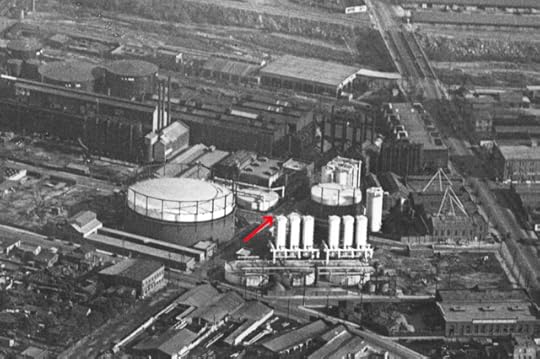
Click to enlarge. The factory gate stood at Ramirez and Howard (arrow) east of the former Chinatown. LAPL.

The Chaplin crew at work filming Modern Times near the corner of Ramirez and Howard (note the street sign at back).
When I read correctly online that Balboa Park in San Diego, and Oheka Castle, the enormous Long Island estate of magnate Otto Kahn, were used to depict Xanadu during the mock newsreel footage from Citizen Kane, I couldn’t help myself, and created these ‘then and now’ images, presented below without further elaboration. Color images (C) Google.
Filed under: Charlie Chaplin, Chinatown, Modern Times Tagged: Chaplin Locations, Charlie Chaplin, Citizen Kane, Humphrey Bogart, Modern Times, Orson Welles, Silent Comedians, Silent Comedies, Silent Movie Locations, The Great O'Malley, then and now

August 15, 2016
Cinecon 2016 Silent Echoes Hollywood Walking Tours

Harold, Buster, and Harold – sites from Never Weaken, a newly discovered scene from My Wife’s Relations, and Safety Last! that we’ll visit on the Cinecon 2016 walking tour.
The block of Cahuenga south of Hollywood Boulevard was the setting for more silent movie filming than any other spot in town. I’ll be leading walking tours of this historic site at the upcoming Cinecon 52 Classic Film Festival during the Saturday and Sunday lunch breaks, September 3 and 4. Although we’ll be heading over from the Egyptian Theater at 6712 Hollywood Boulevard, the tour starts at the SW corner of Hollywood and Cahuenga, at about 12:15 on Saturday, and about 12:50 on Sunday, and you’re welcome to join us there. The tours are free. For those walking from the theater the round trip will be about 1.2 miles. A highlight of the tour will be visiting the site of a newly discovered scene from Buster Keaton’s 1922 comedy My Wife’s Relations (center above), discussed in my prior post HERE.

Visit where Harry Houdini filmed The Grim Game (1919) and Buster Keaton filmed Cops (1922).
You can download a comprehensive PDF tour of Hollywood silent movie filming locations at this link. Hollywood’s Silent Echoes Tour – Cinecon 2016 – John Bengtson

A newly discovered scene! Buster at the Hollywood alley.
You can read other posts highlighting some of the locations we’ll see HERE and HERE.

Click to enlarge. The corner of Hollywood and Cahuenga. Clockwise from the bottom, Harold Lloyd in Why Worry?; Mabel Normand, Charlie Chaplin, and Marie Dressler in Tillie’s Punctured Romance; Buster Keaton in Cops; Douglas Fairbanks in Flirting With Fate; and Mary Pickford in 100% American.
Filed under: Hollywood Tour Tagged: Buster Keaton, Chaplin Locations, Charlie Chaplin, Harold Lloyd, Hollywood Tour, Keaton Locations, Silent Comedians, Silent Comedies, Silent Movie Locations, then and now

July 23, 2016
Amazing New Keaton Discoveries – My Wife’s Relations

Click to enlarge – newly discovered footage from My Wife’s Relations at the Alvarado Arms.
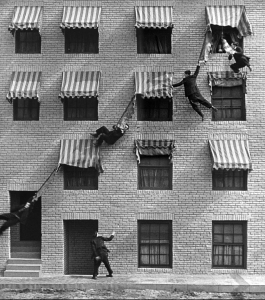
Click to enlarge – an entirely new stunt – who knew this was awaiting discovery for 95 years?
An astonishing new Keaton stunt, Buster’s return visit to a classic apartment house, and yet another surprise appearance of the Cops – The Kid – Safety Last! Hollywood alley – the Lobster Films restoration of My Wife’s Relations (1922) is a cornucopia of new discoveries and delights.
On screen Buster is mistakenly married to a harridan, moves in with her caveman brothers, and after a climatic family brawl, the film concludes (in the version we’ve been accustomed to seeing) as Buster flees for a Reno-bound train. In the Lobster restoration, Buster flees the family apartment, is chased back inside by the cops, only to escape from the top apartment floor by swinging diagonally from upper window awning 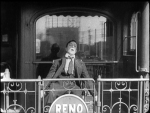 to lower window awning. Dropping safely to street level, Buster’s triumph is short-lived, as he is hauled into the back of a police wagon (where? – at that Hollywood alley, see below). But when the wagon hits a pothole, Buster escapes in time for the final fadeout, presumably headed for that Reno train.
to lower window awning. Dropping safely to street level, Buster’s triumph is short-lived, as he is hauled into the back of a police wagon (where? – at that Hollywood alley, see below). But when the wagon hits a pothole, Buster escapes in time for the final fadeout, presumably headed for that Reno train.

Buster at “the” Hollywood alley. Buster had already filmed here for Neighbors (1920) and Cops (1922), while Chaplin filmed here for The Kid (1921), and Lloyd filmed here for Never Weaken (1921) and Safety Last! (1923). See more below.
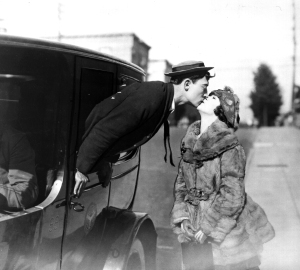
The Alvarado Arms stands behind Buster.
Buster appears in the courtyard of the Alvarado Arms apartments, at 847 S. Alvarado (you can see the “A” initials in the doorway and on the sidewalk post, at top). This was familiar territory, as Buster filmed here the year before for an introductory shot of Virginia Fox (below) walking beside the apartment complex during The Goat (1921). You can also see the twin wings of the Alvarado Arms behind Buster’s head in this publicity shot from The Goat (right), staged in front of the extant Weymouth Apartments, 914 S. Alvarado, that portrayed Virginia’s home during that film.

Deja vu – Virginia Fox appearing in The Goat with the courtyard entrance of the Alvarado Arms behind her.
Although I like to think I would have eventually solved this location mystery, I ‘discovered’ it by what is the most satisfying coincidence I have ever experienced. I viewed this ‘new’ apartment scene for the first time on a Wednesday at my home in the bay area. By that Saturday I had traveled to LA to introduce Safety Last! for the Los Angeles Conservancy’s Last Remaining Seats. Due to downtown crowds, I ended up eating breakfast that day at Langer’s Delicatessen at Alvarado and 7th, and because of where I had parked, decided to take Alvarado to Olympic for my return drive downtown. As I drove past the apartment where Buster filmed Virginia’s introductory shot, I glanced at the interior courtyard. I almost kept going, but something in that brief glimpse caught my eye. Circling the block for a better look, I could clearly see it was the same spot from My Wife’s Relations. So after watching this scene at home in the bay area, there I was, only 3 days later, standing in front of that very spot out of all the spots in Los Angeles! I wish I had this type of luck picking lottery numbers instead, but it sure was fun.
If that wasn’t enough, when I saw that the newly discovered final scene was filmed at the Cops – The Kid – Safety Last! alley, I nearly fell out of my seat.

Click to enlarge – similar views from Never Weaken, My Wife’s Relations, and Safety Last!, both before and after the Palmer Building on Cosmo Street (just south of Hollywood Boulevard) was completed at back.
The discovery of Buster’s new stunt also explains the appearance of the unusual Keaton Studio set visible below.

You can easily see the My Wife’s Relations stunt set in this aerial view of Buster’s studio. Buster used the set later that year for a scene with some police in Day Dreams (1922) (inset). These sets appear in other films described in my Mr. Keaton’s Neighborhood post. HollywoodPhotos.com.
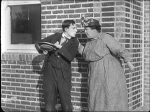 As a further bonus, the scene where Buster first runs into his future bride, played by Kate Price, was filmed at the corner of N. Beachwood Drive and Santa
As a further bonus, the scene where Buster first runs into his future bride, played by Kate Price, was filmed at the corner of N. Beachwood Drive and Santa 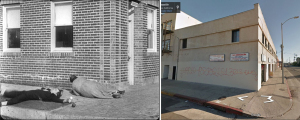 Monica Boulevard, across the street from the Hollywood Forever Cemetery. In the scene at right you can read the 6025 address over the doorway. As shown on the vintage map below, Keaton staged this scene, as with many others, just a few blocks away from his small studio.
Monica Boulevard, across the street from the Hollywood Forever Cemetery. In the scene at right you can read the 6025 address over the doorway. As shown on the vintage map below, Keaton staged this scene, as with many others, just a few blocks away from his small studio.

Another scene from Keaton’s oeuvre filmed just blocks from his small studio on Eleanor and Lillian Way.
My Wife’s Relations from Buster Keaton: The Shorts Collection 1917 – 1923 (C) 2016 Kino-Lorber, Lobster Films.
The Alvarado Arms, twice appearing in Keaton’s films.
Filed under: Buster Keaton, The Goat Tagged: Buster Keaton, Day Dreams, Keaton Locations, Keaton Studio, My Wife's Relations, Never Weaken, Safety Last!, Silent Comedians, Silent Comedies, Silent Movie Locations, The Goat, then and now

June 13, 2016
Saving the Best for (Safety) Last!
 There is no better way to experience Harold Lloyd’s Safety Last! than in a giant 1920’s movie palace packed with audience members gasping and shrieking at every turn. The Los Angeles Conservancy screens this classic thrill comedy on Saturday, June 25, at the Orpheum
There is no better way to experience Harold Lloyd’s Safety Last! than in a giant 1920’s movie palace packed with audience members gasping and shrieking at every turn. The Los Angeles Conservancy screens this classic thrill comedy on Saturday, June 25, at the Orpheum  Theater downtown, as the closing act of its Last Remaining Seats film series. Even if you’ve seen it before, the mass hysterics and contagious laughter will sweep over you, making this an edge-of-your-seat cinematic experience you won’t soon forget.
Theater downtown, as the closing act of its Last Remaining Seats film series. Even if you’ve seen it before, the mass hysterics and contagious laughter will sweep over you, making this an edge-of-your-seat cinematic experience you won’t soon forget.
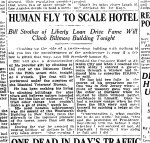 I’m honored to have been invited back by the Conservancy to introduce the film. During my introduction I will point out many downtown film locations, explain the risks and challenges Harold faced when shooting, and show how the unique topography of early Los Angeles directly inspired the movie.
I’m honored to have been invited back by the Conservancy to introduce the film. During my introduction I will point out many downtown film locations, explain the risks and challenges Harold faced when shooting, and show how the unique topography of early Los Angeles directly inspired the movie.
 I’ll also reveal connections between Safety Last! and certain Hollywood tattoo parlors, the post-WWII era’s most famous Santa Claus, and even the landmark Clifton’s Cafeteria that recently re-opened downtown.
I’ll also reveal connections between Safety Last! and certain Hollywood tattoo parlors, the post-WWII era’s most famous Santa Claus, and even the landmark Clifton’s Cafeteria that recently re-opened downtown.
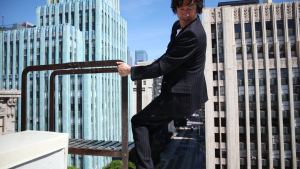 Walking Tours: Prior to the screening I’ll be leading Conservancy walking tours highlighting downtown filming locations used by Harold, as well as by Charlie Chaplin and Roscoe Arbuckle. You can download a shortened PDF version of the tour here. I’ll also be signing my Harold Lloyd film location book .
Walking Tours: Prior to the screening I’ll be leading Conservancy walking tours highlighting downtown filming locations used by Harold, as well as by Charlie Chaplin and Roscoe Arbuckle. You can download a shortened PDF version of the tour here. I’ll also be signing my Harold Lloyd film location book .
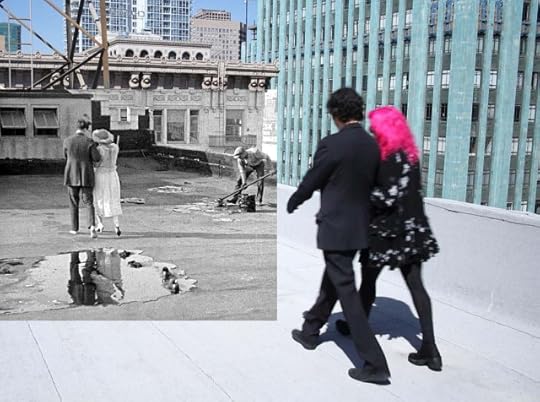
Alfonso Campos and fashion designer Tarina Tarantino reenacting the final scene on the roof of 908 S. Broadway, the same site where the clock sequence pictured at top was filmed, and home now to Tarina’s Sparkle Factory. Guests on the walking tours will be invited to visit this historic rooftop in person.
So do yourself a favor, support a worthy cause, and check out the best possible way to see Safety Last!, with the electric energy of a huge, enthusiastic crowd.
PS – if you need a good laugh, or want to raise your spirits, just listen to noted musician and silent film accompanist Michael Mortilla’s audio-only recording of an audience laughing and squealing with delight while watching Safety Last! It’s great to play as background music – the swells and squeals of laughter just grow and grow.
Audio file of Michael Mortilla accompanying Safety Last! to shrieks and laughter
HAROLD LLOYD images and the names of Mr. Lloyd’s films are all trademarks and/or service marks of Harold Lloyd Entertainment Inc. Images and movie frame images reproduced courtesy of The Harold Lloyd Trust and Harold Lloyd Entertainment Inc.
Filed under: Harold Lloyd, Lloyd Tour, Los Angeles Historic Core, Safety Last! Tagged: Broadway, Harold Lloyd, Los Angeles Conservancy, Los Angeles Historic Core, Man on the Clock, Safety Last!, Silent Comedians, Silent Comedies, Silent Movies, Stunt Climbing, then and now

May 27, 2016
Reflections on Keaton’s Cops at the SF Silent Film Festival
The San Francisco Silent Film Festival starts next week, with another wide and varied lineup of classic silent films accompanied with live musical performances. Comedy fans will be especially interested in the Saturday morning program, introduced by Leonard Maltin, where renowned scientist/film collector/Lon Chaney expert/musician (in no particular order) Jon Mirsalis will present and accompany a restored version of Laurel & Hardy’s epic pie fight comedy, The Battle of the Century (1927). For decades this fan favorite was known only in truncated form until Jon’s recent discovery of a complete print.
The program also includes a restoration of Buster Keaton’s most famous short film Cops (1922), the only movie in Keaton’s oeuvre filmed completely outdoors. I’ve written frequently about the alley on Cahunega, steps south from Hollywood Boulevard, where Buster grabs a passing car one-handed in Cops, showing that Charlie Chaplin (The Kid (1921)), Harold Lloyd (Safety Last! (1923)), and even Harry Houdini (The Grim Game (1919)), filmed there as well.
But the clarity of the new Kino – Lobster Films Blu-ray Buster Keaton: The Shorts Collection release of Cops invites further reflection. For one thing, you can witness several people watching the filming.

Witnesses caught on film – upstairs, a young woman wearing a puff sleeve dress (orange oval) rises from her seat to look down at Buster, while a man watches from across the street (blue oval), and another man inside The Tavern (yellow oval) looks through the glass.
Moreover, 1651 Cahuenga, the reflected building with the diagonally cropped corner entrance standing across the street from the Keaton stunt site (see reversed image below), once a rubber and vulcanizing store belonging to Harley H. Andrews, is now a porn shop. Coincidence? Or simply 90 years of retail evolution?

Harley H. Andrew’s vulcanizing shop now sells Hollywood porn.
A view of the reflected corner building – spin the view around to see Keaton’s alley.
Filed under: Buster Keaton, Cops Tagged: Buster Keaton, Cahuenga alley, Cops, Safety Last!, The Grim Game, The Kid, The San Francisco Silent Film Festival

May 15, 2016
Columbo and the Silent Clowns – Chaplin, Keaton, and Lloyd

Peter Falk as Columbo in A Friend in Deed (1974) crosses Rodeo Drive with the Beverly Wilshire Hotel at back, compared with Charlie Chaplin in City Lights (1931). This episode is nearly closer in time to Chaplin’s era than to our own.
I’ve been enjoying watching Peter Falk as Columbo on Netflix, and am transfixed by the time travel elements of this now decades-old series. The population of Los Angeles has nearly doubled since the time of filming, and there’s something quaint, and poignant, about seeing a handful of cars easily traverse the nearly empty stretches of the Pacific Coast Highway or Wilshire Boulevard presented in the show, that are today impossibly clogged with traffic.

The Newport Beach Pavilion appearing with Buster Keaton in College (1927), and with Suzanne Pleshette in Dead Weight (1971). This episode is now closer in time to Buster’s era than to our own.
Classic film stars like Myrna Loy and Vincent Price play lead roles in the Columbo series, as does Leslie Nielsen in his pre-‘Naked Gun’ days. The homes are stylishly decorated with shag carpets and orange wallpaper, and the men all wear sideburns and extra wide jacket lapels.

Matching views north up Larchmont looking towards Beverly. At left, Harold Lloyd in For Heaven’s Sake (1926), the opening shot of Columbo episode A Stitch in Crime (1973), and Snub Pollard in The Big Shot (1928).
 Since the Columbo murderers are nearly always snobbish millionaires, a remarkable number of classic Los Angeles mansions
Since the Columbo murderers are nearly always snobbish millionaires, a remarkable number of classic Los Angeles mansions 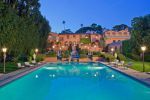 appear in the show. The extant Beverly House owned by William Randolph Hearst (1011 N. Beverly Dr., Beverly Hills), that portrayed the ‘horse-head’ house in The Godfather, appears in ‘Death Lends a Hand’ (see left).
appear in the show. The extant Beverly House owned by William Randolph Hearst (1011 N. Beverly Dr., Beverly Hills), that portrayed the ‘horse-head’ house in The Godfather, appears in ‘Death Lends a Hand’ (see left).

A view of the lost Marion and Thomson estate ‘The Enchanted Hill’ in Identity Crisis (1975).
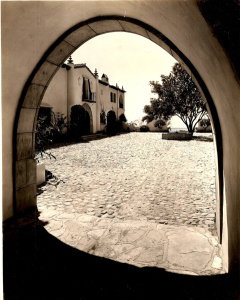
Columbo drove through this arch (above) towards the front door.
The former home of silent film screenwriter Frances Marion and her husband Fred Thomson, known as ‘The Enchanted Hill,’ appears prominently both inside and out in the episode ‘Identity Crisis,’ and also in ‘Fade to Murder.’ Tragically, Microsoft billionaire Paul Allen bought the estate and tore it down in 1997, where it remains an empty site to this day. You can read all about The Enchanted Hill at Steve Vaught’s wonderful Paradise Leased blog HERE.
The episode ‘A Case of Immunity’ is a special treat for Harold Lloyd fans, as it was filmed extensively, inside and out, at Lloyd’s ‘Greenacres’ mansion (1740 Green Acres Place Beverly Hills),in 1975, a few years after Lloyd’s death. Here below are a number of frame grabs of the Lloyd estate from this episode. At the time the double room kitchen had the original stoves and giant iceboxes.

Harold Lloyd’s Greenacres courtyard entrance – Library of Congress.

Rear corner of estate – Library of Congress.

Click to enlarge – views of the entrance courtyard, the interior master staircase, the cascading fountain, now lost to subdivision, that also appears in the 1973 science fiction thriller Westworld, and a free-standing pergola.

The two adjoining kitchen rooms showing the original ice box that can be opened from either room.
During ‘A Friend in Deed’ Columbo crosses Rodeo Drive to visit the Van Cleef and Arpels jewelry store (at top) – it stands today at the same location as in 1974.
Filed under: TV Shows Tagged: Buster Keaton, Charlie Chaplin, Columbo, Frances Marion, Fred Thomson, Greenacres, Harold Lloyd, Peter Falk, Silent Movie Locations, The Enchanted Hill, then and now






